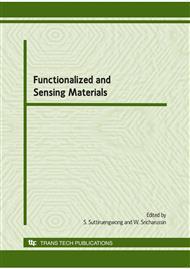p.497
p.501
p.505
p.509
p.513
p.517
p.521
p.525
p.529
Ionic Conductivity of β"-Alumina Solid Electrolyte Prepared by Liquid Phase Sintering Method
Abstract:
Na- β"-alumina solid electrolyte proposed for electric vehicle battery system application was prepared using liquid phase sintering method. Firstly, the Na- β"-alumina powder was prepared according to the formular Na1-xMg2xAl5-xO8 with x = 0.175, calcinations temperature was at 1200 C for 10 h. Calcined powder was milled and mixed with Bi2O3 or CuO in approximate concentration 1, 3 and 5 percent by mole respectively. The uniaxial dry-pressing was employed for green body forming. The green pellets were then sintered at different temperature and dwell time were kept constant for 4 h during the sintering process. Ionic conductivity measurement was performed by impedance analyzer. The XRD characterization on both powder and ceramic show that β"-alumina form as a major phase with tiny amount of the secondary phase β-alumina. The β"/β concentration proportion slightly decrease after sintering. Addition with Bi2O3 or CuO do not lead to phase change and high densification ceramic is obtained. Ionic conductivity of β"-alumina ceramic added with Bi2O3 is higher than that of ceramic with CuO addition. The relative calculated activation energy of the Na+ migration in the former composition is also lower. The highest ionic conductivity measured at 300 C is found in ceramic sample sintered at 1450 C and with 1 mol% of Bi2O3.
Info:
Periodical:
Pages:
513-516
Citation:
Online since:
January 2010
Authors:
Price:
Сopyright:
© 2010 Trans Tech Publications Ltd. All Rights Reserved
Share:
Citation:


